The younger generations are labeled "digital native" among whom smartphone penetration and adoption is high. However, the health consequences of intense utilization of smartphones as a contributor to the increasing prevalence of musculoskeletal disorders in young adults are less explored. This study investigated patterns of musculoskeletal pain, postural abnormalities, and smartphone usage among undergraduate university students.
Four hundred (200 males and 200 females) two-staged sampled undergraduates of the University of Ibadan, Nigeria participated in this cross-sectional study. Data on smartphone usage and 12-month prevalence of musculoskeletal pain were collected using Smartphone Usage Questionnaire and Standardized Nordic Musculoskeletal Questionnaire respectively. A plumb line was used to assess the postural analysis of the participating students and the postural abnormalities discovered were recorded using a postural analysis grid. A picture test consisting of six faulty and six good postures were used to assess the postures assumed by students during smartphone use. Data were analyzed with Kendall tau's b, Eta, Phi, and Cramer's v tests with alpha level set at 0.05.
The 12-month prevalence of musculoskeletal pain affecting the back, neck, shoulder, and wrist were 63.5%, 48.3%, 32.6%, and 24.1% respectively. More females reported a higher proportion of neck (39.5% and 57%), back (56.5% and 70.5%), shoulder (27% and 38%), and wrist (24 and 24.5%) pain in the last 12 months. The rates of postural abnormalities affecting head, shoulders, knees, and feet alignments were 17.5%, 29%, 18.5%, and 34.2% respectively. 73.5% of the participants used their smartphones between 0 to 10 hours on a typical day for reading/studying (100%), phone calls (100%), texting/chatting (99.8%), and accessing the internet (99.8%). There was a significant relationship between duration of browsing the internet (p = 0.019) and 12-month prevalence of low back pain. There was a significant relationship between the duration of reading/studying (p = 0.021) and the 12-month prevalence of neck pain among undergraduate students. There were significant relationships between the 12-month prevalence of neck pain and faulty postures 1 (sitting), 2 (lying with head unsupported), 3 (standing), and 4 (side-lying) (p = 0.007, 0.002, 0.014, 0.039, respectively). There were significant relationships among the 12-month prevalence of knee pain, ankle/feet pain, and faulty posture 2 (p = 0.011 and p = 0.049 respectively). There was a significant relationship between the 12-month prevalence of low back pain and faulty posture 4 (p = 0.019). There were no significant relationships between each of the postural abnormalities and smartphone usage (all p > 0.05).
Neck pain, shoulder pain, wrist pain, and back pain were more common in smartphone using digital natives with a greater proportion of females affected. Most digital natives adopted more faulty postures that predispose them to musculoskeletal pain. Thus inviting the need for, education on postural hygiene and ergonomics among smartphone phone using undergraduates.
Low back pain, Faulty postures, Hand-held devices, Neck pain, Youths, Shoulder pain
Musculoskeletal pain affects the muscles, bones, joints, ligaments, and tendons and has been observed to be one of the most occurring symptoms of musculoskeletal disorder [1]. Musculoskeletal pain is extremely common and affects people of all ages, gender, and sociodemographic background in society including young adults [2]. There has been an increase in the occurrence of musculoskeletal pain especially neck pain, shoulder pain, and low back pain in the young adults' population [3]. A lifetime and point prevalence of musculoskeletal pain of 54.50% and 51.7% respectively were reported from a recent study conducted among undergraduates in Nigeria [4].
The current electronic device in use are smartphones, videogames, computers, laptops, and tablets of which smartphones have become the most common means of communication [5]. Smartphone users in Nigeria are growing rapidly to the extent that Nigeria has become one of the fastest-growing smartphone markets in the world [6]. Different age groups make use of smartphones with young adults having the greatest proportions of smartphone use compared to all other age groups [7]. A great number of young adults are found in universities and these undergraduates have an unregulated usage and over-dependent attitude on smartphones [8].
Posture is defined as the regular and balanced arrangement of skeletal components to preserve the supportive structure of the body from injury and gradual deformation [9]. Different postures that include the static postures of sitting and lying and the dynamic postures of walking are assumed during the use of smartphones [10]. Due to smartphone's portability, it could be used in various postures that may be linked to musculoskeletal exposures that may result in postural abnormalities such as forward head and rounded shoulders [11]. Smartphone users are exposed to awkward neck/shoulder posture and distal upper extremity muscles as a result of how it is designed not to allow the wrists and fingers to rest on the screen interface [12].
Youths own and use smartphones more than all other age groups present in the population [7]. Globally, undergraduate students have unregulated usage and over-dependent attitude on smartphones [8]. They often assume different postures that have a resultant effect of pain at different sites of the body [11]. Studies have shown that there is an association between the use of computers and laptops with musculoskeletal symptoms. Also, some postural abnormalities have been observed to be associated with the use of computers and laptops [13-18]. Only a few studies have investigated the uses of electronic devices with these few focusing on computers and laptops. However, the use of smartphones is different from that of computers and laptops due to their portability and control via a touch screen interface. Smartphones may therefore be associated with different musculoskeletal exposures, which may create different risks for musculoskeletal symptoms than computers and laptops [19].
Therefore, this study investigated patterns of musculoskeletal pain, postural abnormalities, and smartphone usage among undergraduate university students. We hypothesized that there will be significant relationships among musculoskeletal pain, postural abnormalities, and smartphone usage of university undergraduates.
This study utilized a cross-sectional survey research design of a two-staged sampled university undergraduates.
Four hundred undergraduates (200 males and 200 females) were recruited from one of the oldest universities in Nigeria. Five halls of residence (2 male, 2 female, and 1 mixed) were randomly selected from the 10 halls of residence (6 male, 3 females, and 1 mixed) for undergraduate students in this university. The participants were purposively sampled from each of the five selected halls of residence. Participants were included in this study if they were full-time undergraduate students and have used a smartphone for at least 12 months. Undergraduate students with obvious deformity of the musculoskeletal system were excluded from this study. Purposive sampling was used to ensure that only eligible smartphone users were enrolled in the study. The minimum sample size was determined by using Slovin's formula (https://sciencing.com/slovins-formula-sampling-techniques-5475547.html). The minimum number of participants required for the study was calculated as 390 students.
Ethical approval was obtained from the University of Ibadan/University College Hospital (UI/UCH) Research Ethics Committee before the commencement of the study. Written informed consent was obtained from all participants. The Pattern of Smartphone Usage Questionnaire (Appendix 1) and Standardized Nordic Musculoskeletal questionnaire (Appendix 2) [20] were hand-distributed and self-administered by the participants. The Pattern of Smartphone Usage Questionnaire was self-designed and developed to ask questions relating to the pattern of smartphone usage. The questionnaire is a two-part, 5-item tool. Section A consists of demographic information and section B consists of information relating to the duration of smartphone usage, activities commonly carried out on smartphones, and picture test. The picture test consisting of 6 good and faulty postures each was used to assess for the various postures assumed during smartphone use. Five lecturers who are experts in questionnaire development and validation studies assessed the questionnaire for content coverage and relevance. The Standardized Nordic Musculoskeletal Questionnaire (SNMQ) was used for assessing the prevalence of musculoskeletal pain in the nine areas of the body. The nine areas are the neck, shoulders, elbows, wrists, upper back, lower back, hips/thigh/buttocks, knees, and ankle/feet. The SNMQ consists of two sections; the first section consists of 40 items identifying areas of the body causing musculoskeletal pain and the second section consists of 25 items specific to the neck, shoulders, and low back. The test-retest reliability of SNMQ showed moderate to almost perfect reliability with prevalence-adjusted bias-adjusted kappa (PABAK = 0.57-0.90) [21]. The SNMQ has also been shown to have a good construct validity as participants with a musculoskeletal problem in a related region had significantly more pain (p ≤ 0.001) [21]. This questionnaire is an acceptable screening tool and has been used in different countries [22-26].
Postural abnormalities were assessed anteriorly, laterally, and posteriorly using the plumb line method. The plumb line method has good intra-rater reliability for measuring postural variables with an average intra-class correlation (ICC) of 0.80 [27]. One of the authors (DAO) who was trained in postural abnormalities assessment assessed all participants. The plumb line (attached to the horizontal bar of the height meter) was set up in the rooms of the students' halls. The plumb line was aligned to the anatomical landmarks and the deviations were recorded on the postural analysis grid [28] (Appendix 3). When viewed laterally in the erect subject, a good posture should be aligned slightly posterior to the apex of the coronal suture, external auditory canal, bodies of most cervical vertebrae, shoulder joint, lumbar vertebral bodies, slightly posterior to the axis of the knee joint and slightly anterior to the lateral malleolus [29]. When viewed anteriorly or posteriorly, the vertical line passing through the center of gravity should bisect the body into two halves, with the body weight evenly distributed between both feet [30]. Any deviation from this good posture was considered a postural abnormality.
The postural assessment was done using the plumb line method and the observations noted were then recorded on the postural analysis grid. The postural analysis grid contains both the normal observations and the abnormal observations (postural abnormalities) for the various regions of the body. Therefore, the areas to be ticked on the postural analysis grid depend on the corresponding observations seen during the postural assessment. The postural analysis grid contains 23 posture indices representing the six body regions namely head and neck, shoulders and scapulae, thoracic region, lumbar region, pelvis, and lower limbs. The inter-rater reliability was almost perfect for 20 posture indices (K = 0.81-1.00) and moderate for 3 posture indices (K = 0.41-0.60) [28]. The pelvis (anteversion, retroversion, and lateral pelvic inclination), the head (tilt, rotation) and knee (valgus and varus), knee (recurvatum), lumbar spine (hyperlordosis and rectification), thoracic spine (hyperkyphosis and rectification), cervical spine (hyperlordosis and rectification) and the head (protraction) of each student was assessed laterally. Scoliosis, shoulder (imbalance and protraction), and the scapula (winged, abducted, and adducted) of each student were assessed posteriorly.
Data obtained were coded and analyzed using Statistical Packages for Social Sciences (SPSS version 24). Descriptive statistics of percentages, mean, and standard deviation were used to summarize all socio-demographic information of participants. Kendall tau's b test was used to investigate the relationship between the 12-month prevalence of musculoskeletal pain and smartphone usage among students of the University of Ibadan. Phi and Cramer's v test was used to investigate the relationship between faulty/good postures and the 12-month prevalence of musculoskeletal pain. Eta test was used to investigate the relationship between postural abnormalities and smartphone usage. The level of significance was set at 0.05. We used a non-parametric test because most of the responses to the survey variables were categorical. We also checked for normality assumptions for the two (scale/continuous) variables (Age and duration of smartphone usage) in the survey, but they were skewed hence, non-parametric statistics were used for the analysis.
Four hundred (200 males, 200 females) students aged 19.67 ± 2.12 years participated in this study. Almost two-thirds (62%) of the participants were in the first and second year of study. The frequency of participants according to the year of study is presented in Table 1.
Table 1: Socio-demographic characteristics of participants. View Table 1
The duration of smartphone usage among participants was 55.7 ± 27.54 months. Almost two-thirds (63%) of the participants used smartphones for more than five hours daily. The frequency distribution for the duration of smartphone usage on a typical day is represented in Table 2.
Table 2: Duration of smartphone usage on a typical day. View Table 2
The common activities commonly carried out on a smartphone from this study are reading/studying (100%), phone calls (100%), chatting (99.8%) while the least common is blogging (28.5%). The frequency distribution of participants' duration for specific activities is presented in Table 3.
Table 3: Frequency distribution of participant's duration for specific activities. View Table 3
Most of the participants adopted more faulty postures than good postures. The picture test is shown below.
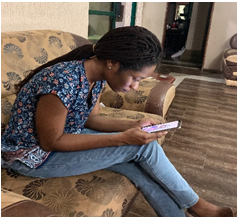
|
Faulty Posture 1 |
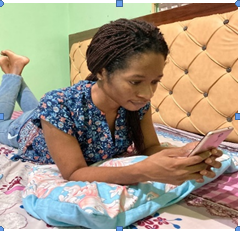
|
Good posture 1 |
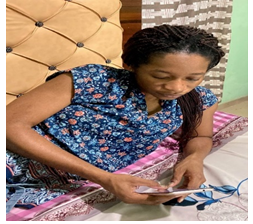
|
Faulty posture 2 |

|
Good posture 2 |

|
Faulty posture 3 |

|
Good posture 3 |
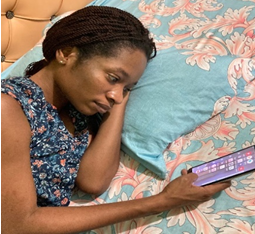
|
Faulty posture 4 |

|
Faulty posture 5 |

|
Good posture 4 |
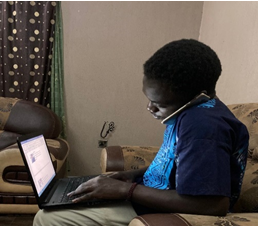
|
Faulty posture 6 |

|
Good posture 5 |
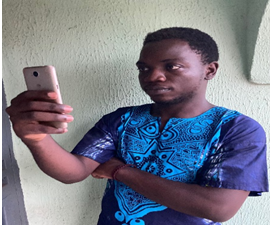
|
Good posture 6 |
More than half of the participants (63.5%) reported back pain while the least reported region was the elbow (8.4%). The 12-month prevalence of musculoskeletal pain is presented in Figure 1.
 Figure 1: Prevalence of musculoskeletal pain and postural abnormalities.
View Figure 1
Figure 1: Prevalence of musculoskeletal pain and postural abnormalities.
View Figure 1
The common postural abnormalities were found in the knees (34.2%) and shoulders (29.0%) while the least common was in the cervical alignment (1.0%). The patterns of postural abnormalities in different body regions are presented in Figure 1.
There was a significant relationship between the duration of browsing the internet (p = 0.019) and the 12-month prevalence of low back pain. There was a significant relationship between the duration of reading/studying (p = 0.021) and the 12-month prevalence of neck pain among undergraduate students. The relationship between the 12-month prevalence of musculoskeletal pain and duration of activities among the undergraduate students is presented in Table 4.
Table 4: Relationship between the 12-month prevalence of musculoskeletal pain and duration of activities among undergraduate students. View Table 4
There was a significant relationship between the 12-month prevalence of neck pain and faulty posture 1 (p = 0.007). There was a significant relationship between the 12-month prevalence of neck pain and faulty posture 2 (p = 0.002). There was a significant relationship between the 12-month prevalence of knee pain and faulty posture 2 (p = 0.011). There was a significant relationship between the 12-month prevalence of ankle/feet pain and faulty posture 2 (p = 0.049). There was a significant relationship between the 12-month prevalence of neck pain and faulty posture 3 (p = 0.014). There was a significant relationship between the 12-month prevalence of neck pain and faulty posture 4 (p = 0.039). There was a significant relationship between the 12-month prevalence of low back pain and faulty posture 4 (p = 0.019). The relationship between the 12-month prevalence of musculoskeletal pain and faulty postures among undergraduate students is presented in Table 5.
Table 5: Relationship between the 12-month prevalence of musculoskeletal pain and faulty postures adopted during the use of a smartphone. View Table 5
There was a significant relationship between the 12-month prevalence of upper back pain and good posture 3 (p = 0.010). There was a significant relationship between the 12-month prevalence of neck pain and good posture 5 (p = 0.027). There was a significant relationship between the 12-month prevalence of upper back pain and good posture 6 (p = 0.000). The relationship between the 12-month prevalence of musculoskeletal pain and faulty postures among undergraduate students is presented in Table 6.
Table 6: Relationship between the 12-month prevalence of musculoskeletal pain and good postures adopted during the use of a smartphone. View Table 6
The relationship between postural abnormalities and smartphone usage among undergraduate students is presented in Table 7.
Table 7: Relationship between postural abnormalities and smartphone usage among undergraduate students. View Table 7
This study assessed patterns of musculoskeletal pain, postural abnormalities, and smartphone usage among university undergraduates. The participants included in this study were undergraduate students aged between 16 and 28 years. Most of the population who make use of smartphones and other digital devices are the millennials and these millennials fall into the 15-29 age range of the youths who are majorly undergraduates. The age range of participants used in this study agrees with findings from a previous population of undergraduate studies carried out [31,32]. This could be explained by the fact that the minimum age of admission into the University where participants for this study were selected is 16 years. In this study, more than half of the students (55%) have used their smartphones for about 5 years and 40% have used their phones for about 3 years. This is in line with findings on a similar study on the duration of smartphone usage that reported that 36.6% and 35.7% of students have used their smartphones for more than 4 years and 3 years, respectively [33]. The reason for this duration of smartphone usage could be as a result of the portability and the numerous advanced functions that the smartphone can perform. It could also be as a result of the population studied, which is known to be the ones with the highest ownership and use of a smartphone device [31]. Findings from this study indicate that most of the students (73.5%) used their phone between 5 to 10 hours. This finding is in line with that of similar studies on the duration of smartphone use [31,33].
A larger population of the participants used their smartphones for chatting, watching videos, playing games, phone calls, browsing the internet, video calls, reading, and photography. This finding is similar to a study carried out on smartphone activities that reported that 42.5% used their smartphones or chatting, 38. 2% used them for searching the internet, 12.55% used them for playing games, 3.0% used them for typing documents and 3.8% used them for other activities [31]. These findings are also similar to another study carried out on smartphone activities where the majority of the students carried out these same activities on their smartphones which were texting/chatting, internet browsing, e-learning, phone calls, music, videos, pictures, playing games except for the addition of scheduling and emails [32]. This could be because most students in Nigeria see no reason for scheduling using their smartphones instead they prefer to just do all the scheduling in their head. It could also be because students in this country are not exposed to technology as many of their schoolwork such as assignments do not involve the use of technology as many assignments are still submitted in hard copies to various lecturers.
A picture test, which comprised of both good and faulty postures, was used to find out the postures that were common with the participants. This picture test was used because it was easier for the participants to relate to than just using words to describe each of these good and faulty postures. Findings from this study showed that most of the students adopted faulty postures in lying, sitting, and standing during the use of a smartphone than the good postures in these same positions. In a study on posture assumed during the use of smartphone in which words were used to describe the various postures, most of the students adopted postures majorly in lying on the back (37.4%), sitting (36.4%), lying on the face (14.5% and standing (9.8%) [31]. In another study in which words were also used to describe various postures, it showed that a large population of the students adopted postures in sitting (76.2%), supine (23.4%), side-lying (17.6%), prone (14.3%) and standing (13.5%) [32]. There was no clarification on whether these postures were faulty or not from the two studies. This could be because it is not easy to ascertain whether the postures adopted were faulty with the use of words, unlike this study where a picture test was carried out making it very easy for ascertaining whether the postures adopted by the students were faulty or not.
In this study, abnormal feet (34.2%) and shoulder (29%) alignment were the most common postural abnormalities among the participants. This could be because of the flat-heeled shoe participants wear regularly especially among the females. The abnormal shoulder alignment could be because the shoulder is actively involved during the use of a smartphone. In this study, most of the participants reported back pain, shoulder pain, wrist pain, and neck pain as the most common site of pain in the body. This finding is in line with a study carried out on musculoskeletal pain that reported that neck pain and shoulder pain were the symptoms commonly experienced by the students [31]. In a study carried out on laptops, the most common areas of pain experienced by the students were shoulder and neck pain [15]. This could be because of the type of carrier bags used for laptops as single strap bags and backpacks were commonly observed to be the most common types used by the students.
In this study, there was no significant relationship between the duration of smartphone activities (chatting, watching videos/movies, playing games, phone calls, blogging, video calls, reading, photography) and the 12-month prevalence of low back pain among students of the University of Ibadan. This may be due to the ages of the participants used in the study as the low back is more prevalent among the elderly population. There was a significant relationship between the duration of browsing the internet and the 12-month prevalence of low back pain. This may because this is a major tool participant use daily as revealed from this study with 99.8% of participants having browsed using their smartphones. There was no significant relationship between the duration of smartphone activities and the 12-month prevalence of neck pain among students in this study. This may be due to the ages of the participants used in this study, as neck pain is more prevalent among the elderly population. There was a significant relationship between the duration of reading/studying and the 12-month prevalence of neck pain among students. This may be as a result of the need to read on a continuous basis daily and in which many adopt faulty postures while doing this. There was no significant relationship between the duration of smartphone activities and the 12-month prevalence of shoulder pain among students of the University of Ibadan. This may be due to the ages of the participants used in this study as shoulder pain is more prevalent among the elderly population.
In this study, there was a significant relationship between the 12-month prevalence of neck pain and four out of the 6 faulty postures. This may be because the students make use of their smartphones below the level of the eye thereby bending the neck for a prolonged period. Also, all four faulty postures did not allow for the normal curvatures of the neck. In this study, there was a significant relationship between the 12-month prevalence of low back pain and a faulty sitting posture. This probably could be as a result of prolonged sitting posture without support mostly adopted by the students especially when they use a smartphone. In this study, there was a significant relationship between the 12-month prevalence of knee pain/ankle pain and a faulty standing posture. This could be because of the prolonged standing posture adopted while making use of a smartphone. In this study, there was no significant relationship between the 12-month prevalence of shoulder pain, elbow pain, wrists/hand pain, upper back, hip/thigh pain, and the faulty postures. This could be because musculoskeletal pain is more prevalent among the elderly population when compared to the age range of the participants in this study. Our findings of significant relationships between the 12-month prevalence of neck pain, knee pain/ankle pain, low back pain does not align with the findings of Can and Karaka [34] who reported no significant relationship between pain complaint and posture (p > 0.05).
In this study, there were significant relationships among the 12-month prevalence of neck pain, upper back pain, and good postures. One would have expected that a 12-month prevalence of musculoskeletal pain should not associate with the adoption of good postures. Our findings suggest that the duration of smartphone use even while adopting a good posture may pose as a confounding factor. Long hours of smartphone use without breaks in between use are detrimental to musculoskeletal health even when a good posture is adopted. In this study, there was no significant relationship between the 12-month prevalence of shoulder pain, elbow pain, wrists/hand pain, hip/thigh pain, knee pain, ankle pain, and good posture.
The results obtained from this study were not able to ascertain truly if the postural abnormalities were exclusively from smartphone usage as the researcher was not able to control for the use of other electronic devices. The authors observed that usage of smartphones could affect the thumb and the affectation of the thumb specifically was not considered in this study based on the content of the instrument used for the data collection (the Nordic pain questionnaire). The questionnaire only allowed for information on the wrists and hands.
Neck pain, shoulder pain, wrist pain, and back pain were more common in smartphone using digital natives with a greater proportion of females affected. Most digital natives adopted more faulty postures that predispose them to musculoskeletal pain. Thus, inviting the need for, education on postural hygiene and ergonomics among smartphone phone using undergraduates. It is of great importance to develop and evaluate preventive approaches against musculoskeletal complaints, especially among young people. Enlightenment programs and postural education on adopting good postures during smartphone usage should be incorporated in the training of these students possibly through seminar presentations. This will help in creating awareness to students on the detrimental effects of improper postures adopted during smartphone use. Emphasis should also be made on avoiding prolonged hours of smartphone use as prolonged hours of the smartphone could also be detrimental to musculoskeletal health even when adopting a good posture.
Nil.
This research did not receive any specific grant from funding agencies in the public, commercial, or not-for-profit sectors.
https://clinmedjournals.org/articles/jmdt/jmdt-6-089-appendix-file.pdf